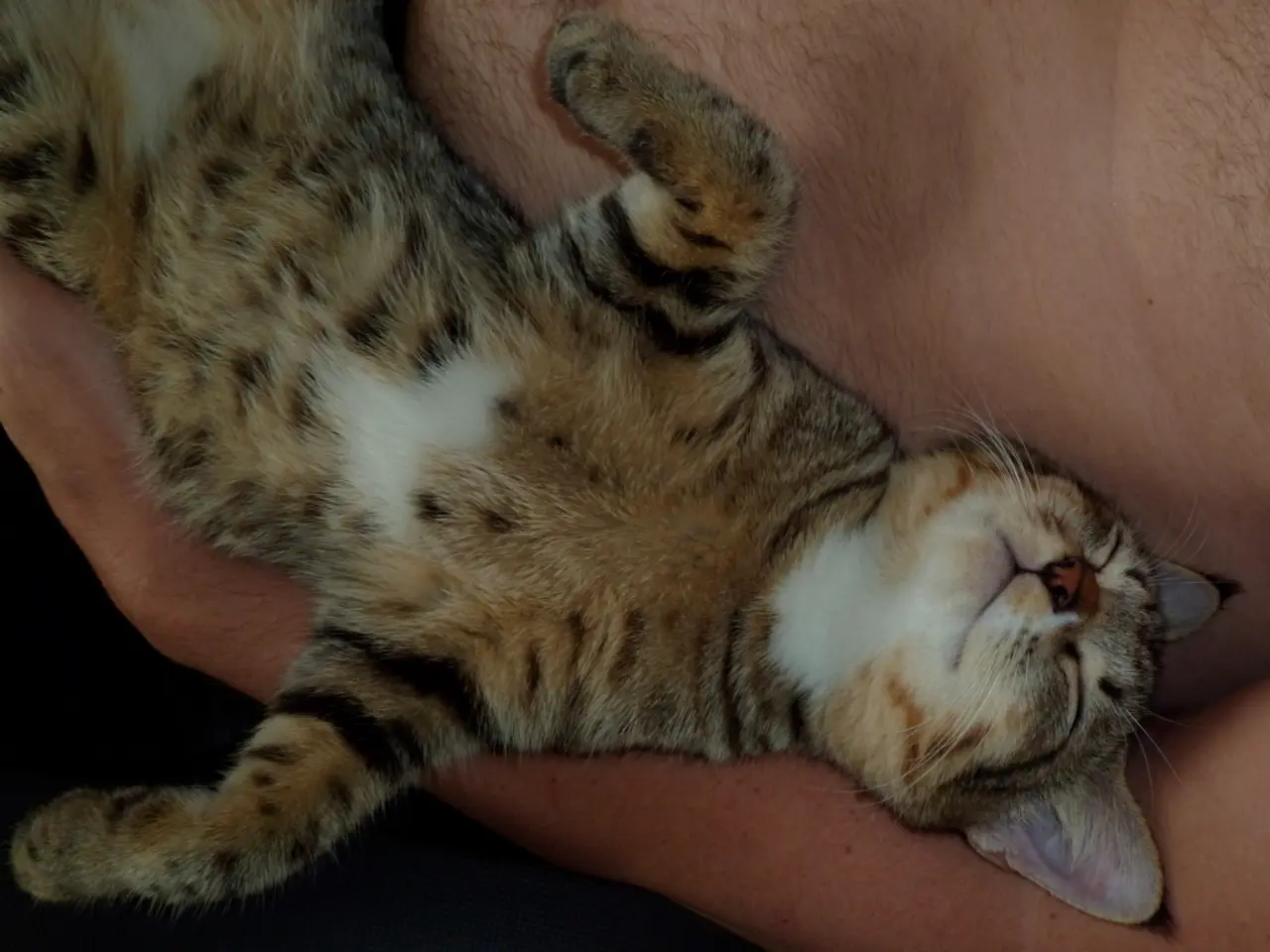Cat Bite Safety Measures, First Aid Procedures, and Seeking Emergency Assistance
Cat bites can lead to a range of infections, making prompt medical attention crucial. Here's a breakdown of the common infections associated with cat bites and the appropriate treatment.
Most cases of Sporotrichosis, an infection caused by a fungus, affect only the skin and are not life-threatening. However, if a person is bitten by a cat and develops a small red, pink, or purple bump that grows larger and looks like an open sore or ulcer, they may have Sporotrichosis. If it affects the lungs, a person may experience coughing, chest pain, fever, and shortness of breath. The most common treatment for Sporotrichosis is an antifungal medication called itraconazole.
Another common infection is Pasteurella multocida, a bacterium found in cat saliva. This can rapidly cause cellulitis and abscesses, leading to localized swelling, redness, and pain around the bite site. Pasteurella multocida can cause pain, swelling, inflammation, cellulitis, and abscesses.
Cat scratch disease, caused by Bartonella henselae, can take about a month to show signs of infection and may require antibiotics for severe or persistent symptoms. It's transmitted by a bite or scratch and leads to swollen lymph nodes and fever.
Tetanus is another bacterial infection that can develop from a cat bite if the person's immunization status is not current. If a person experiences a cat bite from an animal that appeared healthy at the time, and can locate the owner, the owner should confine the cat for 10 days and observe it for symptoms.
Though rare in the United States due to vaccination programs for domesticated animals, rabies is a neurologic disease that can spread through the bites of animals with the infection. A cat with rabies will experience sudden changes in its behavior, progressive paralysis, restlessness, panting, and may attack others animals or people. If the cat is rabid or exposed to rabies, the virus can be transmitted via bite, and post-exposure prophylactic treatment is necessary.
Treatment for infections from cat bites generally involves antibiotics, wound care, tetanus vaccination, rabies post-exposure prophylaxis (PEP) if needed, surgical intervention in severe cases, hospitalization for severe or systemic infections, and monitoring the cat's health if it's the pet of the injured person.
It's important to note that cat bites can create deep puncture wounds that are difficult to clean, allowing bacteria or other organisms to become trapped deeper in the skin. This increases the risk of infection, with general estimates ranging from 20% to 80%.
In addition to these infections, contact with cat feces can lead to toxoplasmosis, a concern especially for pregnant women and immunocompromised persons.
To prevent infectious diseases, cat owners should take their pets to a veterinarian for routine care. If a stray cat has caused the bite, a person should wash the wound with soap and water for 5 minutes and contact a doctor immediately.
In summary, cat bites can transmit bacterial infections such as cellulitis, abscesses, cat scratch disease, tetanus, and potentially rabies. Prompt medical attention, wound care, and appropriate antibiotic treatment are essential to prevent complications.
- Aq cat scratch disease can take about a month to show signs, requiring antibiotics for severe or persistent symptoms.
- Cat saliva can carry Pasteurella multocida, a bacterium that can cause rapid cellulitis and abscesses.
- Sporotrichosis, an infection caused by a fungus, is common with cat bites, but if it affects the lungs, symptoms may include coughing, chest pain, fever, and shortness of breath.
- Cat bites can result in deep puncture wounds, increasing the risk of infection.
- Bertonella henselae causes cat scratch disease, which leads to swollen lymph nodes and fever.
- Tetanus can develop from a cat bite if a person's immunization status is not current.
- A cat with rabies may show signs of sudden changes in behavior, progressive paralysis, restlessness, panting, and aggression towards animals or people.
- Tetanus post-exposure prophylactic treatment is necessary if a cat is rabid or exposed to rabies.
- Treatment for cat bite infections may involve antibiotics, wound care, tetanus vaccination, rabies post-exposure prophylaxis, surgical intervention, hospitalization, and monitoring a pet's health.
- Infectious diseases can be prevented through routine veterinary care for pet cats.
- Contact with cat feces can lead to toxoplasmosis, especially concerning for pregnant women and immunocompromised persons.
- Prompt medical attention and appropriate treatment are essential to prevent complications from cat bite infections.
- Science plays a critical role in understanding and treating medical conditions like those related to cat bites.
- Medical-conditions like chronic diseases, respiratory conditions, and digestive health can be better managed through predictive diagnosis and tailored therapies and treatments.
- Atopic dermatitis and ankylosing spondylitis are chronic diseases that require ongoing treatment and management.
- Migraine can be debilitating, but there are various treatments available, including medication, therapy, and lifestyle modifications.
- Depression can be managed through a combination of medication, therapy, and lifestyle adjustments like exercise, a healthy diet, and social support.
- Pet ownership can provide companionship and mental health benefits, but it's crucial to consider the responsibilities involved.
- Science extends beyond medical-conditions to environmental science, climate change, and issues like cybersecurity.
- Environmental-science focuses on understanding and preserving the natural world, addressing challenges such as pollution, deforestation, and conservation.
- Finance plays a role in individual and business affairs, including wealth management, personal finance, banking and insurance, and investing.
- Skin conditions, such as eczema and psoriasis, can be managed through a combination of skin-care products, therapies, and lifestyle adjustments.
- Therapies and treatments for various conditions can be found across the healthcare and wellness industry, with new advancements in technology and artificial intelligence.
- The industry is constantly evolving, from advancements in autoimmune disorders treatments to innovations in hearing aids and improved eye-health solutions.
- Space-and-astronomy reveals much about the universe, offering insights into physics, chemistry, and the origins of life on Earth.
- Lifestyle changes, such as adopting a healthier diet, quitting smoking, or exercising regularly, can lead to significant health benefits.
- Fashion-and-beauty industries offer a wide range of products and services, from skincare and makeup to clothing and accessories.
- Food-and-drink choices can impact overall health, with various nutritional advice available for managing conditions like diabetes and heart disease.
- Wealth management, investing, and personal finance can help individuals achieve their financial goals and maintain a stable financial future.
- Businesses and personal finances go hand-in-hand, with various resources available for small business development, networking, and entrepreneurship.
- Personal-growth and education-and-self-development resources can help individuals overcome challenges, develop skills, and reach their potential.
- Shopping, social media, movies-and-tv, career development, and pop-culture all play a role in modern lifestyle, providing entertainment, connection, and personal expression.




